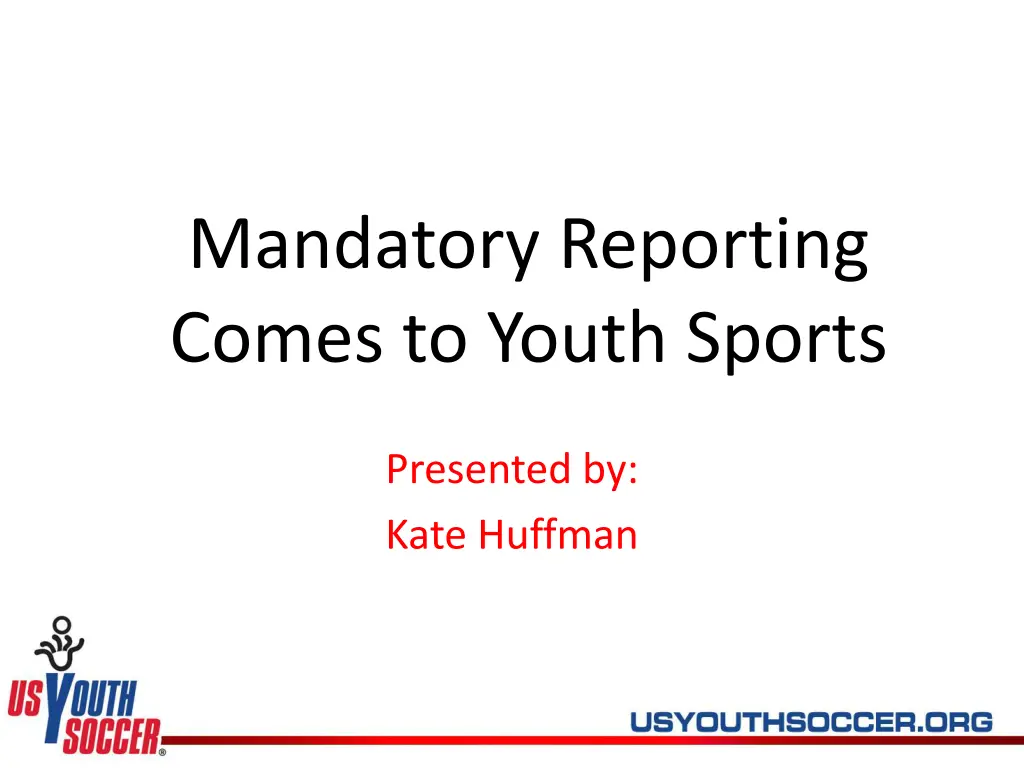
Mandatory Reporting in Youth Sports
Explore the importance of mandatory reporting in youth sports, covering risk management efforts, failure consequences for not reporting, the Safe Sport Act, who are mandatory reporters, when to report abuse, and the reporting process to authorities and the U.S. Center for Safe Sport.
Download Presentation

Please find below an Image/Link to download the presentation.
The content on the website is provided AS IS for your information and personal use only. It may not be sold, licensed, or shared on other websites without obtaining consent from the author. If you encounter any issues during the download, it is possible that the publisher has removed the file from their server.
You are allowed to download the files provided on this website for personal or commercial use, subject to the condition that they are used lawfully. All files are the property of their respective owners.
The content on the website is provided AS IS for your information and personal use only. It may not be sold, licensed, or shared on other websites without obtaining consent from the author.
E N D
Presentation Transcript
Mandatory Reporting Comes to Youth Sports Presented by: Kate Huffman
Risk Management Efforts Background checks Field safety Goal safety Emergency services Medical care Concussion protocols Mandatory reporting
Mandatory Reports Health care professionals Social workers Teachers and other school employees Lawyers Mental health professionals Day care employees Camp employees Clerics and other employees of religious organizations
Failure to Report May result in: Civil damages Criminal responsibility Loss of licensure
The Safe Sport Act A reaction to failures to report abuse in youth sports organizations, including USA Gymnastics. Broadens state reporting requirements. Expands mandatory reporting laws to all youth sports organizations participating in international or interstate sporting events governed by a national body.
The Safe Sport Act Prevent sexual abuse in youth sport through: Prevention training Prevention policies Mandatory reporting
Who are mandatory reporters? Any adult authorized to interact with minor or amateur athletes Coaches Trainers Referees All volunteers All administrators
Must Report When The mandatory reporter knows or has reasonable cause to suspect, or a reasonable person in a similar position would suspect, that an amateur athlete under 18 years of age has suffered abuse.
Reporting Must report suspicion of abuse to local authorities within 24 hours. Must also report to the U.S. Center for Safe Sport.
Information Requested by Authorities Contact information for reporter How the reporter obtained knowledge of the allegations The reporter s relationship with the alleged victim When the reporter learned of the alleged abuse What actions have been taken to ensure the safety of the child Information on others who may have knowledge of the alleged abuse
Protections Generally, reporting is confidential. The contents of reports often may not be obtained by any individual, including any suspect. Reports are immune from civil or criminal liability for making a report, provided the report was made in good faith.
Summary Mere suspicions must be reported. Report must be made to the local law enforcement agency or other governmental agency, as established by state law.
Required Prevention Procedures Must establish specific procedures to limit one-one-one interactions between adults and minors. Examples: No transportation except with others present; no electronic communications except to group; no touching except by trainer in presence of another adult
No transportation except with others present No electronic communications except to group No touching except by trainer in the presence of another adult
Prevention Training Amateur sports organizations shall offer and provide consistent training to all adult members who are in regular contact with amateur athletes who are minors, and subject to parental consent, to members who are minors, regarding prevention and reporting of child abuse
Prevention Training Must be proactive and preventive. Must not focus on reacting to abuse that has occurred. Recognition of grooming behavior. Focus on what may place a child at risk of abuse such as: Unsupervised one-on-one interaction. Unmonitored contact.
Prevention Policies Must include: Mandatory reporting Mechanisms for reporting Prevention practices Procedures to prohibit retaliation Regular and random audits to ensure policy and training compliance
Reporting Policies In writing Written acknowledgment of receipt by mandatory reporters Scheduled renewed training Policies reviewed on a periodic and regularly scheduled basis - example: every two years Establish a dedicated and disinterested oversight board
Reporting Mechanism Supply all mandatory reporters with the contact information for the local reporting agency. The person with suspicion must report avoid I thought you reported. The mandatory reporter must also, after contacting local authorities, report to a specific risk management staff member. Risk management staff should report to the state or national governing body.
Reporting Policies Written policies Available electronically Written acknowledgment of receipt by mandatory reporters Reviewed on a periodic and regularly scheduled basis - example: every two years Establish a dedicated and disinterested oversight board Consequences for non-compliance Document everything!
Important Issues Record maintenance and retention Sharing of information Database of offenders Training and follow-up Policy reviews Reporting to state and national organization(s) Follow-up
